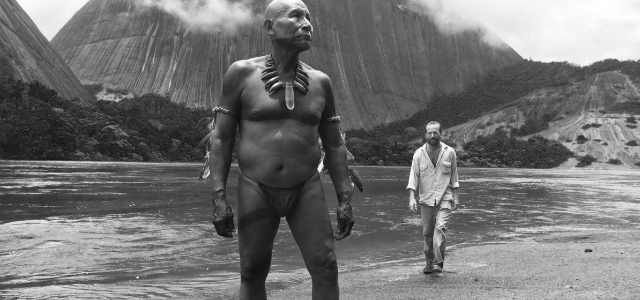Embrace of the Serpent
A poetic, dreamlike journey of beauty, friendship and brutality.
Plot summary
In search of the mythical healing Yakruna plant, two scientists, forty years apart, set out on a journey into the depths of the rainforest guided by Amazonian shaman Karamakate.

Ciro Guerra’s third feature film submerses you into the sights and sounds of the Amazon in a poetic, dreamlike journey of beauty, friendship and brutality. The noises of the rainforest and the sounds of the river are the backdrop to an historical adventure with strong political and environmental undertones.
Karamakate, the last survivor of his people, takes us through the depths of the jungle on two occasions, reluctantly retracing the steps of his original journey with explorer Theo (Theodor Koch-Grunberg) forty years later with scientist Evan (Richard Evans Schultes). The film follows their search for the difficult-to-find psychedelic Yakruna plant with Karamakate as their physical and spiritual guide.
The film opens with Manduca, played by Yauenkü Miguee, seeking the help of the young shaman to heal his sick and fevered companion Theo, played by Jan Bijvoet (Borgman). Whilst, Evan, played by Brionne Davis (Narcissist), encounters an older and world-wearied Karamakate who he seeks as his guide in search of Yakruna.
The film moves between the two journeys as they snake along the river in parallel. We see the impact of the rubber trade and slavery on the forest and its inhabitants. In one disturbing scene you are confronted by a local, crippled and disfigured rubber farmer. Reliant on the rubber for survival yet enslaved by the Europeans, he is left by the explorers to his fate.
In a dark parallel to The Mission the role of Jesuits and religion is confronted. On a stopover at a Spanish mission, the impact of the actions of the younger Karamakate and his travelling companions comes back to haunt the shaman. On his return to the mission years later, the children once under the control of a strong-armed priest and left to their own rule have pieced together Catholic ideas with native traditions but dire consequences. In a Heart of Darkness-esque amalgamation, the concepts of the savage and the civilised are morphed into as Karamakate says, the worst of both worlds.
And it is Karamakate and his insights and views on nature and the world that are central to the film. We see the important balance in nature and the disintegration of this equilibrium through man’s exploitation of its resources. We also bear witness to the impact of colonialism and the destruction of indigenous tribes and their traditions but through the lens of a dreamlike exploration of the environment and the minds of the travellers. In the conversations between Karamakate and his two European explorers, what may be regarded as modern views are questioned by the practical wisdom of the native. Guerra engages with these issues in a way that creeps up on you and does not distract you from the beauty of the landscape. At the end you feel privileged to have been exposed to these unseen parts of the jungle and the company of Karamakate.











COMMENTS